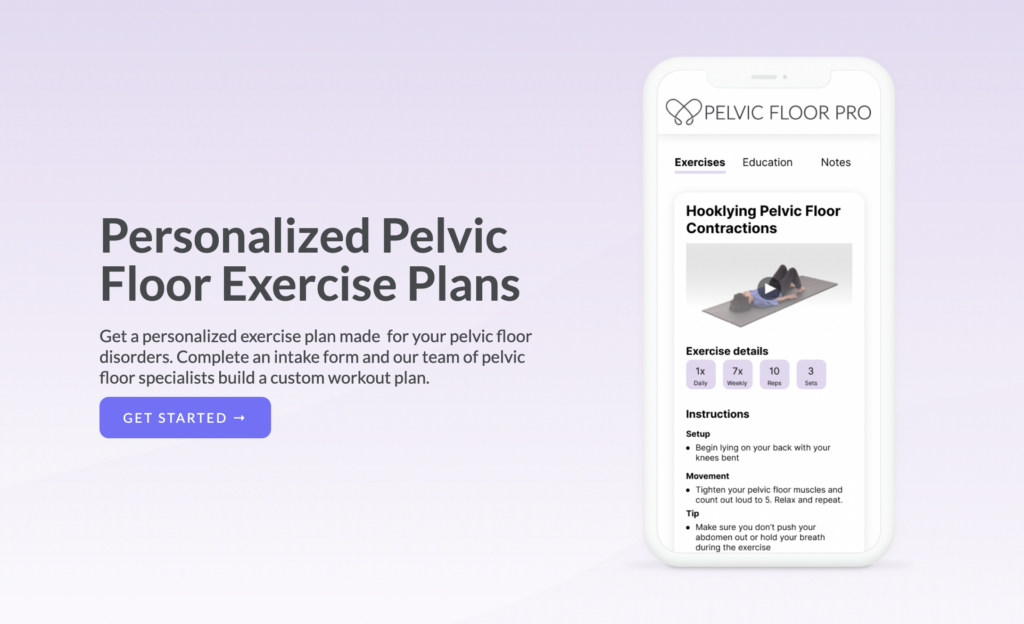Pelvic Pain After Running
You may not be able to remember when you first noticed it. The nagging, persistent pain in your hip, that small dribble that occurs each time you hit your stride – urinary incontinence and hip pain are two indications you may be one of the millions of people dealing with pelvic floor dysfunction.
While it may sound concerning, you have hope and options. Keep reading to learn more about why you may be experiencing pelvic pain while running and the steps you can take to reduce or eliminate it.
Related Articles
Get Personalized Therapy for Your Pelvic Floor Dysfunction
Improve pelvic floor dysfunction symptoms in only 2 – 3 months from home.
With targeted exercise alone most women can improve their pelvic floor function in 60 to 90 days. Generic exercises won’t get these outcomes, only personalized plans based on your symptoms. This is why intake forms and professional plans are so important.
Learn more with the button below.
Runner’s Pelvic Pain Explained
Quite a few runners experience pelvic pain when they are running. Found between the legs and abdomen, the pelvis provides support for your spinal column and houses the following:
- Reproductive organs
- Bladder
- Intestines
You may begin to feel pelvic pain related to running in several areas, including the following:
- Buttocks
- Pelvis
- Hips
- Lower back
It can also originate from a lack of stability in your core muscles, lumbopelvic muscles, and muscles of the pelvic floor.
Signs You May be Dealing with Runner’s Pelvic Issues
There are a few signs you can watch for that indicate you are dealing with a runner’s pelvic pain or issues.
Urinary or Fecal Urgency
If you have to plan your run around restroom locations, there’s no question it can limit the places you can go and how far you can run. It’s also bound to take away some of the enjoyment from the running experience. Something that is even more frustrating is having to stop in the middle of your run to use the restroom only to discover that you really don’t have to go much.
Research has shown that the myofascial trigger points in the pelvic floor muscles may lead to a sense of urgency by causing something called neurogenic bladder symptoms.
You can have manual therapy to release the myofascial trigger points to help improve or fully resolve the urgency symptoms in both females and males.
Urinary or Fecal Leakage
It’s estimated that 41% of female athletes have experienced some level of urinary incontinence. This can vary from just a few small dribbles to moisture seeping down their leggings and all the way to their knees.
No matter how much leakage you experience, urinary and fecal leakage are both signs that your pelvic floor cannot handle what you are doing (in this situation, running). Leakage is directly related to pelvic floor muscle dysfunction.
This can include muscle spasms, decreased coordination, muscle weakness, trigger points, or a combination of these factors. The trigger points can result in poor firing of the muscle fibers, which results in reduced muscle activation. You may experience muscle weakness as decreased power, endurance, or both.
Poor coordination can result in inadequate timing of muscle contractions, which means the muscles don’t “activate” quickly enough to keep this leakage from occurring. If you are dealing with dysfunction, then your muscles are not healthy enough to adapt to the forces you experience while you run while ensuring continence.
Feelings of Pressure or Heaviness
Do you experience a sensation of pressure or heaviness in your pelvis? If so, it may be a sign of pelvic organ prolapse. This is when one or more of the pelvic organs begin to make a downward descent. Usually, it involves the rectum, bladder, or uterus.
To ensure proper support for the organs against intra-abdominal pressure, the connective tissues and muscles in the area must be healthy. Running results in an increase in intra-abdominal pressure and require a supportive and strong pelvic floor. If your pelvic floor muscles aren’t healthy, it may result in a prolapse, which causes this heaviness or pressure.
Pain
You should never experience pain after your run. While muscular soreness from a challenging route is normal and something that all runners experience at some point, it should not be pain.
If you notice pelvic pain while you are running, it can be caused by the pelvic floor muscles. It’s important to have your strength, pelvic floor muscle function, gait, alignment, and posture evaluated to determine what strategies you must adopt to start running pain-free again.
Piriformis Syndrome
While you may have never heard of your piriformis muscle, if it is “acting up,” you are going to know it. The piriformis muscle is found in the buttocks and is a very narrow muscle. If this muscle becomes compressed or contracts and irritates your sciatic nerve, you may develop piriformis syndrome.
Some of the symptoms of this condition include tingling, numbness, and pain. You may feel these sensations in your buttocks and radiating down your legs. Sometimes, this pain and discomfort worsen after you climb stairs, run, walk, or sit.
Diagnosing the Cause of Pelvic Pain Caused by Running
After you schedule an appointment for an evaluation, one of the first things you should do is to create a list of all your symptoms. On this list, be sure to include when the pain or discomfort began, what you have done to alleviate the pain, how much pain you are in, if the pain seems to be getting better or worse, any prior injuries you have experienced.
After a physical exam, you may be referred to a specialist (like us). We can then do further evaluations to determine the underlying cause of your pain and help you overcome it and enjoy running again.
Treatment Options for Running Related Pelvic Pain
The treatments required for pelvic pain vary based on your needs and how severe the condition is. Some common treatment options include:
- Utilizing the R.I.C.E. method of treatment
- R- Rest
- I – Ice
- C – Compression
- E – Elevation
- Massage
- Pain meds
- Physical therapy
- Strength training
- The P.O.L.I.C.E. protocol
- P -Protect
- O & L -Optimal load
- I – Ice
- C – Compress
- E – Elevate
If you experience any type of pelvic pain while you run, it’s best to seek an evaluation right away. We are here to help and can find the underlying issue and the right treatment method to help alleviate the pain and discomfort you experience while running.



